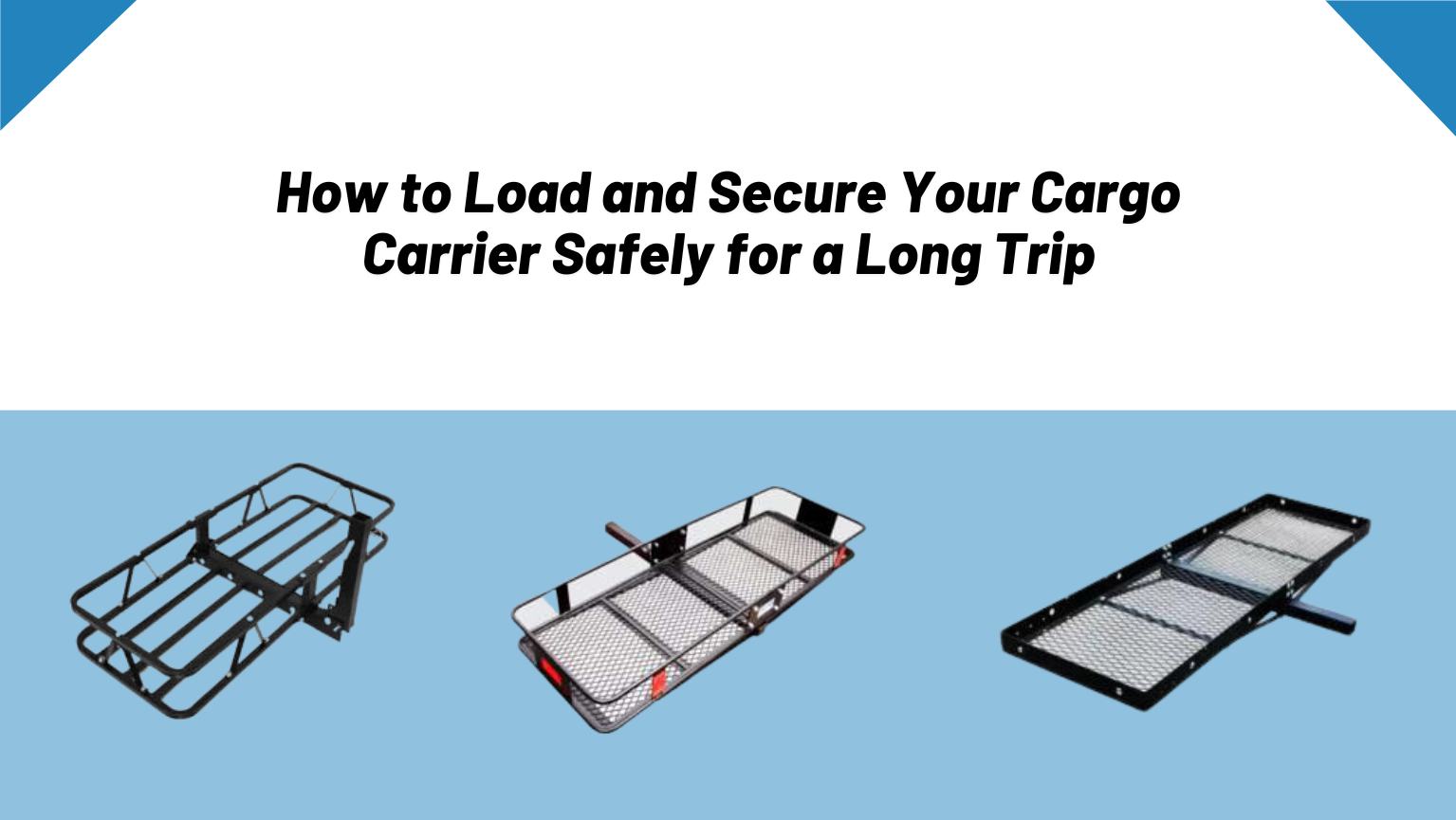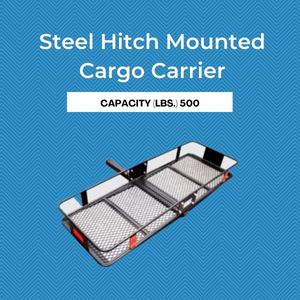Safely Loading and Securing Your Cargo Carrier for Long Trip
Are you planning a long road trip and need extra gear or supplies? A cargo carrier can provide you with the additional space you need. However, loading and securing a cargo carrier is more complex than throwing everything on your vehicle. Follow these tips to safely load and ensure your cargo carrier for a long trip.

Choosing the Right Cargo Carrier for Your Vehicle and Needs
Before loading your cargo, ensure a suitable carrier for your vehicle and needs. Cargo carriers come in different types and sizes; choosing one appropriate for your vehicle’s weight capacity and storage needs is essential.
Types of Cargo Carriers: There are several cargo carriers, including roof-mounted, hitch-mounted, and trunk-mounted carriers. Roof-mounted carriers are the most common and come in complex and soft-shell versions. Hitch-mounted carriers are mounted on the vehicle’s rear and are often used for heavier items. Trunk-mounted carriers are the least expensive option and are easy to install, but they can limit access to the trunk.
Considerations for Your Vehicle: When choosing a cargo carrier, consider the weight capacity of your vehicle and the load capacity of the page. You should also ensure the carrier is compatible with your vehicle’s roof rack or hitch.
Capacity and Size: The size of your cargo carrier will depend on how much gear you need to bring along. Remember that a more extensive page will add more wind resistance and affect your vehicle’s fuel efficiency.
Preparing Your Cargo and Carrier for the Trip
Once you’ve chosen the suitable cargo carrier, it’s time to prepare your cargo and transport for the trip.
Assessing Your Cargo: Before loading your cargo, assess what you need to bring along and ensure it’s all necessary. This will help you avoid overloading your carrier and making your vehicle difficult to handle.
Cleaning and Inspecting Your Carrier: Check your cargo carrier for any damage or wear and tear before loading your cargo. It would help if you also cleaned the page to remove debris or dirt.
Assembling Your Carrier: If your carrier requires assembly, follow the instructions carefully. Ensure all the parts are securely fastened and the page stable.
Securing Your Cargo Carrier to Your Vehicle
Before hitting the road, ensure your cargo carrier is securely fastened to your vehicle.
- Using the Right Straps and Tie-Downs: Use high-quality straps or tie-downs to secure your cargo carrier to your vehicle. Make sure the straps are tight and that there is no slack.
- Checking for Stability and Security: Check your cargo carrier for stability and security before driving. Shake the airline to make sure it’s not loose or wobbling.
- Following Local and State Regulations: Ensure you follow local and state regulations when driving with a cargo carrier. Some states have specific requirements for securing cargo to a vehicle, so check before you hit the road.
Different Types of Cargo Carriers and Their Features:
Sure, here’s a chart to help illustrate the different types of cargo carriers and their features:
Type of Cargo Carrier | Features |
Roof-mounted carriers | Most common type; comes in hard shell and soft shell versions; easy to install; may affect fuel efficiency due to wind resistance |
Hitch-mounted carriers | Mounted on the rear of the vehicle; can handle heavier items; can limit access to the trunk; may affect vehicle handling and stability |
Trunk-mounted carriers | Least expensive option; easy to install; can limit access to the trunk; may have lower weight capacity |
Remember to choose a cargo carrier that’s appropriate for your vehicle’s weight capacity and storage needs.
Best Hitch-Mounted Cargo Carrier
Finding the best hitch-mounted cargo carrier can make all the difference in your road trip or outdoor adventure. Look for pages with sturdy construction, high weight capacity, and convenient features like folding and easy assembly. Mesh floors and sidewalls can help secure your cargo while allowing easy cleaning and drainage. Additionally, consider the carrier’s size and shape to ensure it fits your vehicle and cargo needs. With the suitable hitch-mounted cargo carrier, you can enjoy a stress-free and convenient way to transport your belongings.

Steel Hitch Mounted Cargo Carrier
A steel hitch-mounted cargo carrier is a type of cargo carrier that is designed to fit into the hitch receiver of a vehicle. This type of carrier is made of steel, making it durable and sturdy enough to handle heavy loads. Steel hitch-mounted cargo carriers are popular among truck and SUV owners who need extra storage space for camping gear, sports equipment, or other bulky items. They come in various sizes and weight capacities, making choosing one that fits your vehicle’s specifications and storage needs easy. One advantage of a steel hitch-mounted cargo carrier is that it provides additional storage space without taking up interior space. However, it’s important to note that a steel hitch-mounted cargo carrier can add weight to the vehicle and affect its handling and stability. To ensure safe and stable transportation, it’s important to properly secure the cargo carrier and evenly distribute the weight of the load.
Conclusion
In conclusion, safely loading and securing your cargo carrier for a long trip is essential to ensure a safe and stress-free journey. Safety should always be a top priority when travelling with a loaded cargo carrier. Before loading your cargo carrier, check its weight capacity, distribute it evenly, and secure the items with proper tie-downs. Choosing the right page that suits your vehicle and cargo needs is also crucial. Additionally, remember to double-check the security of the carrier and cargo before hitting the road. Following these simple steps, you can enjoy a smooth and worry-free journey with your cargo carrier.
FAQ's
- How can I determine my vehicle’s weight capacity for a cargo carrier?
You can check your vehicle’s manual or contact the manufacturer for information on the weight capacity of your vehicle’s hitch, roof, or trunk. Choosing a cargo carrier within this weight capacity is essential to ensure safe transportation.
- What are some accessories I can use with a hitch cargo carrier?
Some popular accessories for hitch cargo carriers include cargo bags, cargo nets, and tie-down straps. These accessories can help secure and protect your cargo from the elements during transportation.
- Are roof-mounted cargo carriers a good option for long trips?
Roof-mounted cargo carriers can be a good option for long trips, but they may affect fuel efficiency due to wind resistance. Additionally, loading and unloading a roof-mounted carrier can be more complex than other cargo carriers.
- How can I distribute the weight of my cargo on a cargo carrier?
It’s important to evenly distribute the weight of your cargo on a cargo carrier to ensure safe transportation. Start by placing heavier items in the centre of the airline and then fill in the rest of the space with lighter items. Use tie-down straps to secure the load and prevent shifting during transportation.

